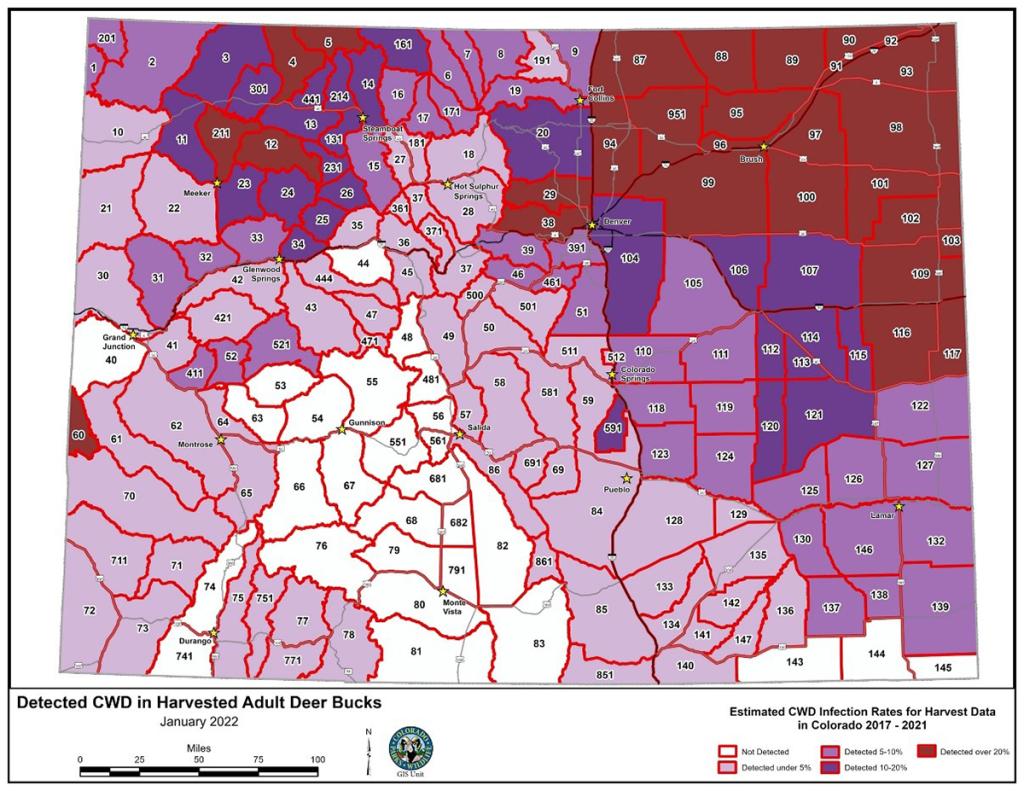Colorado Parks and Wildlife presents results of mandatory testing for chronic wasting disease at May Commission Meeting in Sterling


From 2017-2020, CPW focused mandatory testing on deer because deer have the highest disease infection rates and greatest need for disease management. During this time, CPW examined CWD levels across all 54 deer herds. CPW focused on elk in 2021, which provided the first reliable infection rate estimates for elk since the mid-2000s. In 2022, CPW will restart the five-year rotation, shifting its attention back to deer.
A variety of management methods have already been utilized around the state since mandatory testing began. When infection rates are greater than 5%, wildlife managers have utilized tactics such as:
- Reducing population or density
- Reducing male/female ratio (males tend to have double the infection rates of females)
- Changing the age structure (4- to 6-year-old bucks tend to have the highest infection rates)
“Overall, the decision to commit to annual mandatory testing has been resoundingly important to understanding the status of this disease in Colorado,” Eckert said. “It’s helped us in acquiring and communicating reliable infection rate estimates and laying a foundation to assess herd-specific management actions to combat CWD. We are now taking management actions in 27 of our 54 deer herds.”
2021 Mandatory CWD Testing Summary
 Map of CWD infection rates in harvested adult and yearling elk in Colorado, 2017-2021.
In 2021, CPW tested its 14 highest priority elk herds, with special emphasis on those that overlap high-prevalence mule deer herds. Eckert said the testing helped CPW learn that:
Map of CWD infection rates in harvested adult and yearling elk in Colorado, 2017-2021.
In 2021, CPW tested its 14 highest priority elk herds, with special emphasis on those that overlap high-prevalence mule deer herds. Eckert said the testing helped CPW learn that:
- CWD in elk is still relatively low in elk herds statewide.
- Detection of infected yearling elk is higher than expected.
- Geographic patterns of high infection level areas generally overlap for elk and deer.
“We would not be able to determine this relationship and response to disease management efforts in deer without knowing the infection rates in both deer and elk in overlapping herds,” Eckert said. “Additionally, we retested six mule deer herds to increase the number of harvest submissions used to estimate infection rates in those herds.”
Read the complete CWD update to the Commission here.
What is CPW doing to address CWD?
CPW is working to ensure the long-term health of deer, elk and moose herds. Over time, this means minimizing the number of animals that get infected and die from this disease. To date, management actions have been prescribed for 27 deer herds that intend to reduce infection levels to below 5%. More information about our plan to manage CWD is available in the Colorado Chronic Wasting Disease Response Plan.
The CWD Response Plan establishes a compulsory management threshold, which means when infection rates exceed 5% in adult (older than 2 years) male deer, then some form of management actions will be taken to reduce infection rates until they fall below the 5% threshold. CPW identifies various management actions in the plan that are available to local managers to prescribe in herd management efforts, all of which have the potential to help reduce infection rates in deer herds.
What are the health risks to humans?
CWD is a prion disease that affects Colorado’s deer, elk and moose. The disease course generally lasts 2 - 3 years in deer and is always fatal. Although there has been no evidence that CWD has transmitted to a human, the Center for Disease Control, CPW and the Colorado Department of Public Health & Environment all recommend that hunters not eat the meat of a CWD-infected animal.
More information about CWD is available on CPW’s website.
More information on prion diseases is available on CDPHE’s website.
Colorado Parks and Wildlife (CPW) is an enterprise agency, relying primarily on license sales, state parks fees and registration fees to support its operations, including: 43 state parks and more than 350 wildlife areas covering approximately 900,000 acres, management of fishing and hunting, wildlife watching, camping, motorized and non-motorized trails, boating and outdoor education. CPW's work contributes approximately $6 billion in total economic impact annually throughout Colorado.
DISCLAIMER: The Colorado Parks and Wildlife (CPW) website maintains press releases containing historical information that may no longer be accurate. Press releases are dated, which should be noted to determine whether the information provided is current. Please review our current regulations and brochures for up-to-date information.
 Travis Duncan
Travis Duncan